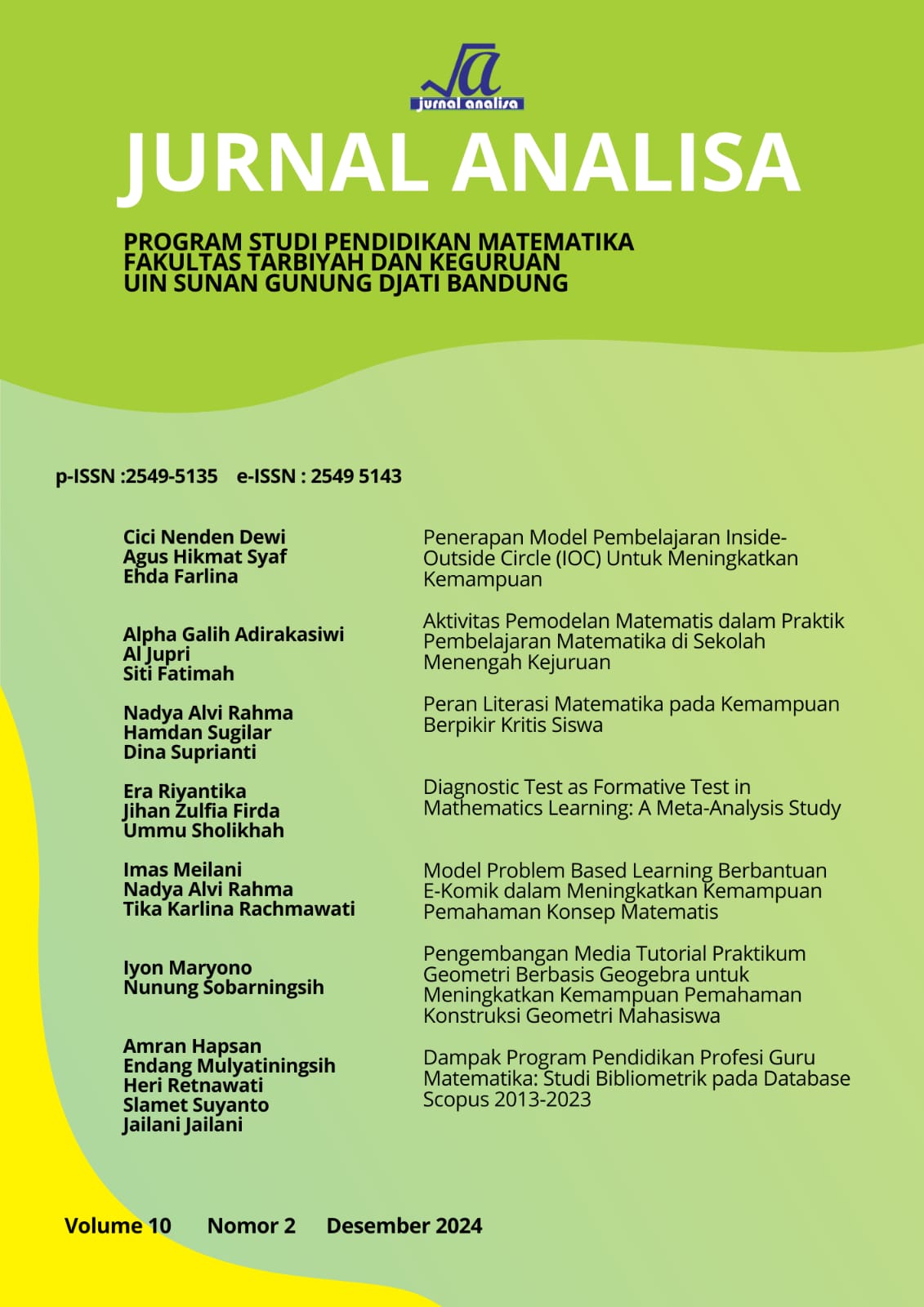Diagnostic Test as Formative Test in Mathematics Learning: A Meta-Analysis Study
DOI:
https://doi.org/10.15575/ja.v10i2.29911Keywords:
Mathematics, Diagnostic Test, Formative TestAbstract
Students have diverse learning abilities; thus, the role of the teacher as a facilitator is profoundly needed. Teachers have to recognize the initial abilities of each student through assessment activities so that teachers can identify students' abilities. This article aims to determine the influence of using diagnostic tests as a formative test in improving mathematics outcomes. The method used is meta-analysis by comparing information from several identical literature studies. Based on the analysis of 4 literature, diagnostic tests can improve students' learning outcomes by forming a heterogeneous group. A comparison of students' learning improvement can be observed by the percentage of learning mastery results before and after the diagnostic test, which carries out a statistical test, paired t-test. Students' learning outcomes were assessed by the percentage of learning mastery before and after using diagnostic tests, which were then processed using a statistical test paired sample. The test showed that the average increase in learning outcomes from the pretest was 63.93 to 81.68. It indicates that the student's learning outcomes have improved after using a diagnostic test as a formative test in mathematics learning.References
Alzahra, A., Pasani, C. F., & Amalia, R. (2024). Pengembangan Tes Formatif Matematika Materi Aljabar Smp/Mt Berbasis Etnomatematika Pasar Martapura. Jurmadikta, 4(1), 10–22. https://doi.org/10.20527/jurmadikta.v4i1.2422
Anggraeni, H. B., Subali, B., & Apriani, R. (2017). Pengembangan Tes Formatif yang Berfungsi sebagai Tes Diagnostik Kesulitan Belajar Pokok Bahasan Animalia. Jurnal Pendidikan Biologi, 6(6), 341–352.
Azka Fuadia, L., & Lya Diah Pramesti, S. (2023). Analisis Instrumen Asesmen Formatif dalam Meningkatkan Kemampuan Memecahkan Masalah Matematika Siswa. Prosiding Santika 3: Seminar Nasional Tadris Matematika Uin K.H. Abdurrahman Wahid Pekalongan, 2011, 315–327.
Duskri, M., Kumaidi, K., & Suryanto, S. (2014). Pengembangan Tes Diagnostik Kesulitan Belajar Matematika Di Sd. Jurnal Penelitian Dan Evaluasi Pendidikan, 18(1), 44–56. https://doi.org/10.21831/pep.v18i1.2123
Hikmasari, P., Kartono, K., & Mariani, S. (2018). Analisis Hasil Asesmen Diagnostik dan Pengajaran Remedial pada Pencapaian Kemampuan Pemecahan Masalah Matematika melalui Model Problem Based Learning. PRISMA, Prosiding Seminar Nasional Matematika, 1(1), 400–408. https://journal.unnes.ac.id/sju/index.php/prisma/article/view/19610
Maharani, C. K., & Rinaningsih. (2015). Pengembangan Tes Diagnostik Dalam Media Cetak Teks Terprograma Pada Materi Pokok Laju Reaksi. UNESA Journal of Chemical Education, 4(1), 90–98.
Nurpaidah, S. (2016). Peningkatan Kualitas Hasil Belajar Kimia (Oksidasi Reduksi) pada Siswa Kelas X SMA Negeri 3 Watampone Melalui Pembelajaran Remedial dengan Tutor Sebaya. Jurnal Chemica, 17(1), 34–43.
Purba, A. (2016). Penerapan Pembelajaran Koperatif dengan Pendekatan Struktural TPS Dan TSTS Untuk Meningkatkan Hasil Belajar Matematika Siswa Kelas X5 Sma Negeri 1 Tambang. MES (Journal of Mathematics Education and Science), 2(1), 24–32. http://scioteca.caf.com/bitstream/handle/123456789/1091/RED2017-Eng-8ene.pdf?sequence=12&isAllowed=y%0Ahttp://dx.doi.org/10.1016/j.regsciurbeco.2008.06.005%0Ahttps://www.researchgate.net/publication/305320484_SISTEM_PEMBETUNGAN_TERPUSAT_STRATEGI_MELESTARI
Putri, K. P., Rinaningsih, D., Pd, S., & Pd, M. (2013). Pengembangan Tes Diagnostik Materi Teori Mekanika Kuantum Dan Ikatan Kimia the Development of Diagnostic Test Chapter Quantum Mechanics Theory and Chemical Bonding. Unesa Journal of Chemical Education, 2(2), 159–172.
Sadewo, Y. D., Purnasari, P. D., & Muslim, S. (2022). Filsafat Matematika: Kedudukan, Peran, Dan Persepektif Permasalahan Dalam Pembelajaran Matematika. Inovasi Pembangunan : Jurnal Kelitbangan, 10(01), 15–28. https://doi.org/10.35450/jip.v10i01.269
Saidah, K. N., & Rinaningsih. (2012). Pengembangan Tes Diagnostik dengan Menggunakan PHP-MySQL pada Materi Pokok Laju Reaksi untuk SMA Kelas XI. Unesa Journal of Chemical Education, 1(1), 145–153.
Sawaluddin, S. (2018). Konsep Evaluasi Dalam Pembelajaran Pendidikan Islam. Jurnal Pendidikan Agama Islam Al-Thariqah, 3(1), 39–52. https://doi.org/10.25299/althariqah.2018.vol3(1).1775
Sugiyamti, S. (2018). Peningkatan Hasil Belajar Membuat Skets Grafik Fungsi Aljabar Sederhana Pada Sistem Koordinat Kartesius Melalui Metode Cooperatif Learning Jigsaw Pada Siswa Kelas Viii F Smp Negeri 6 Sukoharjo Semester I Tahun Pelajaran 2017/2018. Jurnal Ilmiah Edunomika, 2(01), 175–186. https://doi.org/10.29040/jie.v2i01.195
Sulastri, S., Supriyati, Y., & Margono, G. (2019). Peningkatan Hasil Blajar Siswa Melalui Asesmen Diagnostik dalam Pembelajaran Lintas Minat Kimia. Prosiding Seminar Nasional Pendidikan KALUNI, 2, 722–733. https://doi.org/10.30998/prokaluni.v2i0.160
Yasir, I. (2016). Evaluasi Diagnostik dan Remedial oleh Guru dalam Proses Pembelajaran. Jurnal BAPPEDA, 2(3), 186–192.
Zhao, Z. (2013). An Overview of Studies on Diagnostic Testing and its Implications for the Development of Diagnostic Speaking Test. International Journal of English Linguistics, 3(1), 41–45. https://doi.org/10.5539/ijel.v3n1p41
Downloads
Published
Issue
Section
License
Authors who publish in Jurnal Analisa agree to the following terms:
1. Authors retain copyright and grant the journal right of first publication with the work simultaneously licensed under a Attribution-ShareAlike 4.0 International (CC BY-SA 4.0) License that allows others to share the work with an acknowledgment of the work's authorship and initial publication in this journal.
2. Authors are able to enter into separate, additional contractual arrangements for the non-exclusive distribution of the journal's published version of the work (e.g., post it to an institutional repository or publish it in a book), with an acknowledgment of its initial publication in this journal.
3.Authors are permitted and encouraged to post their work online (e.g., in institutional repositories or on their website) prior to and during the submission process, as it can lead to productive exchanges, as well as earlier and greater citation of published work (See The Effect of Open Access).
